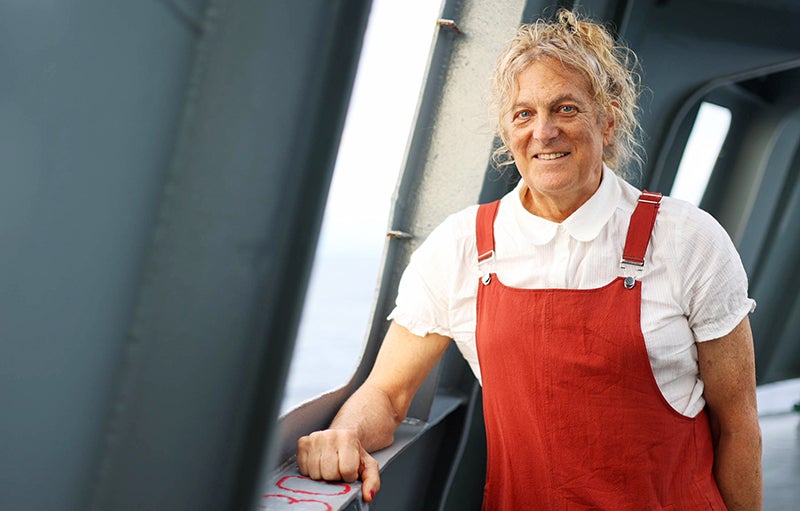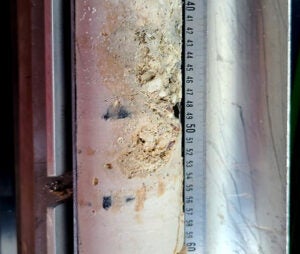Professor Kenna Rubin to Manage and Grow the Research Portfolio
By Alexander Castro

Editor’s Note
In early July, 2023, Kenna Rubin joined the faculty as associate dean for research. Rubin will be working to grow GSO’s research portfolio and assist campus partners on research collaborations across the university’s colleges, as well as at the state, federal and international levels.
The following article is an in-depth look at Rubin’s own research, as it happened at sea, on a science cruise in the Pacific.
As an oceanographer, volcanologist, geochemist and environmental chemist, Rubin focuses on environmental impacts of submarine volcanism, and paleo records of sea level change from coral reef settings. Before coming to GSO, she was a faculty member at the University of Hawaii for 31 years, where her teaching has focused on environmental chemistry, geochemistry and volcanology. Rubin strongly believes that migrating ocean science to all digital workflows, persistent identifier tagging, complete metadata documentation, open access data sharing and rapid dissemination of information are keys to major advances in environmental and climate research conducted in the coming decades.
A novel made up entirely of correspondence has never been the standard format for prose narratives. But it’s never disappeared either. Authors from Goethe to Stephen King have used letters to craft stories that range from yearning to scary.
Writing about the work of Kenna Rubin, the new associate dean at GSO, was not unlike this literary device. As this report’s deadline neared, Rubin had limited internet access. So she replied to questions across time zones, across a continent even, whenever she had a few moments.
A comparison to the “epistolary novel” isn’t misplaced given the epic context for Rubin’s poor signal: she was at sea for more than 10 weeks this fall on International Ocean Discovery Expedition 389, dubbed “Drowned Hawaiian Reefs.”
As the catastrophic-sounding title suggests, Expedition 389 studied submerged coral reefs off Hawaii’s Big Island. These reefs were once at sea level but, as Rubin explained, they “rafted downward with the rest of the island as it sinks under its own weight.”
How does an island gain weight? Volcanic eruptions, it turns out, can be a landmass’ version of “bulking up.” In this case, all that accumulated mass and time adds up to a weighty—and revealing—geological history.
Armed with a remote-controlled commercial seabed drill, Expedition 389 cored the Big Island’s sunken reefs to “recover info about a half-million years of past climate records, the rate of sinking, and coral reef responses to sea level change,” Rubin explained. These stories from the seabed are “very difficult to obtain by any other means.”
While much of the cruise’s research is embargoed for a year, Rubin could speak in “generalities” about the project. For an expedition working with millennias’ worth of oceanic history, generalities should suffice.
As one of three inorganic geochemists on the ship’s science team, Rubin played a key role in analyzing coral samples. The drill trawled the seabed for these samples and, after coring, pulled them up in the form of rock cylinders. Sometimes these tubes of rock reached the ship broken. But intact specimens, Rubin noted, showed “the innards of the coral reefs.”
These fossilized coral guts offered a richness of data to help “reconstruct…past climate and environmental records from when the reefs grew,” Rubin wrote. Different corals grow in different conditions, and Rubin said “things like water clarity, nutrient supply, wave action, and temperature” all affect not only which types of corals thrive but also if reefs can form.
Using radiocarbon or Uranium-thorium geochronology, Rubin identified the samples. What kinds of coral were being recovered, and how old were they? As of this writing, Rubin was still on the expedition, but back on land she’ll continue dating the coral, adding the results into her “ongoing research into the effects of rapid sea level change on coral reef ecology and morphology,” she explained.
“I am very interested in periods of past rapid sea level change as an analog for the future,” Rubin wrote. “Specifically, I look at how reefs change in response to sea level rise upticks lasting a few centuries, because this should provide clues about what the next few centuries have in store for tropical coastal communities who depend on coral reefs for the wide variety of ecosystem services they provide.”
During our extended interview, Rubin occasionally emailed the equivalent of scenic postcards in the form of JPEGs or screen-captured tweets.
 “Here is a picture of a core showing various now-skeletal remains for reef organisms preserved in the column of rock,” Rubin wrote about the attached picture.
“Here is a picture of a core showing various now-skeletal remains for reef organisms preserved in the column of rock,” Rubin wrote about the attached picture.
From a lay perspective it was hard to know exactly what to look for in Rubin’s picture of a hard, crumbly column of off-white. But after reading her explanation of coral guts, it became more legible to this untrained eye. Changes in color and texture weren’t outwardly dramatic, but they told a story thousands of years in the making. What kinds of coral survived? What reefs grew to the size of empires? What other organisms were denizens of these fascinating sprawls?
Rubin has been looking at coral reefs for 25 years. The reefs’ past ecology and their relationship to sea level change has formed the nucleus of her research.
“Ironically, my work on reefs is near and dear to my heart, but not the thing I am MOST known for,” Rubin wrote. “Rather, I am most recognized globally as an expert on volcanoes and volcanism.”
The not-so-odd couple of volcanoes and reefs also points toward the marriage of oceanography and Earth sciences: “Many marine geologists would not be able to function without significant understanding in both,” Rubin said.
Her own intertwining path began with a bachelors in chemistry, followed by postgraduate studies culminating in an M.S. and Ph.D. at Scripps Institution of Oceanography. By then it was the mid-1980s, which Rubin noted as “a time of rapid expansion in studies of the seabed.” So she pivoted from seawater chemistry to the study of submarine volcanoes, employing chemistry, ocean science and volcanology in a blend uncommon for the period.
“My niche in the ocean sciences is on using deep submergence tools in innovative ways,” Rubin said, a specialty that’s involved 30 piloted submersible dives and “a couple hundred more remotely operated dives.”
The research cruises are thrilling, yes, but so is teaching. Rubin calls it a “passion,” with her role of professor echoing her childhood curiosity: to instill an understanding and advocacy for the world we inhabit.
“Personally, I am most energized by projects that have both scientific and human dimensions,” Rubin said, something she hopes to continue at GSO by “do[ing] research that is not only academically sound, but also directly helpful to ordinary citizens in their everyday lives.”
One upcoming project involving GSO colleagues and students is a proposal for “a deep submergence study…of volcanism and hydrothermal activity” which entails taking the ALVIN submersible at sites that are “way deeper than the Titanic,” Rubin said.
The depths, apparently, are where it’s at: “The vast majority of the seabed remains unmapped, uncharted and unseen by human eyes,” Rubin wrote, adding that we know “far less” about most of the Earth’s surface crust and the seabed than we do Mars.
Even the deepest depths need their story told. Unfortunately the most distant reaches of the sea can’t write novels, letters or laments. Their story might be more easily told with pictures. Thankfully, those have gotten better, too.
Rubin said “real-time, well-illuminated, well-geolocated 4K images [collected] miles below the sea surface” now exist. Such resolution was unthinkable in the days of slide film and VHS tapes [when I started doing this.]” For Rubin and researchers like her, these advances make our world more tangible. It’s certainly something to write home about.
